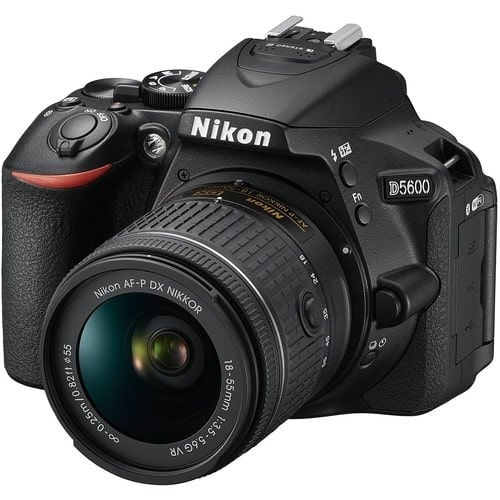What is a DSLR Camera?
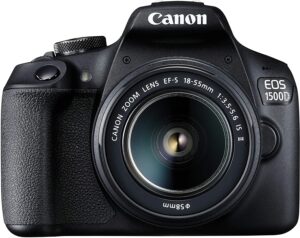
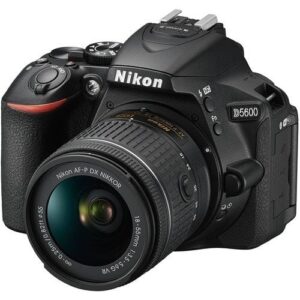
A DSLR camera, or a digital single-lens reflex camera, is a type of digital camera that uses a mirror and prism system to reflect light from the lens into the optical viewfinder. The optical viewfinder allows the photographer to see the scene and compose the shot before capturing the image.
When the photographer presses the shutter button, the mirror flips up, allowing the light to pass through the shutter and onto the camera’s image sensor. The image sensor captures the light and converts it into a digital signal, which is then processed and stored as a digital image file.
DSLR cameras offer a range of manual controls, including the ability to adjust aperture, shutter speed, and ISO, as well as the option to change lenses, giving photographers more creative control over their images. They are known for their versatility and high-quality image capture, and are commonly used by professional photographers for a variety of applications, including portrait, landscape, and sports photography.
While DSLR cameras have traditionally been the go-to choice for many photographers, mirrorless cameras have gained popularity in recent years due to their smaller size, lighter weight, and comparable image quality. However, DSLR cameras continue to be a popular choice for many photographers who require the extra versatility and control they offer.
“DSLR” Camera Kya Hota Hai?
DSLR ka matlab hota hai “digital single-lens reflex” aur ye ek tarah ka digital camera hota hai. DSLR camera ek mirror aur prism ka upyog karta hai jisse ki camera ke viewfinder mein dikhayi dene wala subject aur image ko photographer dekh sake.
Jab photographer shutter button ko press karta hai, toh mirror camera ke andar flip ho jaata hai aur light camera ke image sensor tak pahunch jaati hai. Image sensor light ko capture karta hai aur use digital signal mein convert karke ek digital image file ke roop mein store kar deta hai.
DSLR camera mein lens aur exposure settings jaise ki shutter speed, aperture aur ISO control karne ki flexibility hoti hai, jisse ki photographer apne according image ko customize kar sake. Ye camera landscape, portrait, sports, wildlife photography jaise bahut saare applications mein use kiya jaata hai.
DSLR cameras traditional photographers ke liye bahut popular hai, lekin recent years mein mirrorless cameras bhi kaafi popular ho gaye hain. Mirrorless cameras ka size aur weight kam hota hai aur unke comparable image quality ke karan bahut saare photographers inhein prefer karte hain. Lekin, DSLR cameras abhi bhi bahut saare photographers ke liye ek popular choice hain, jo inke extra versatility aur control ke liye choose karte hain.
How “DSLR” Camera Works?
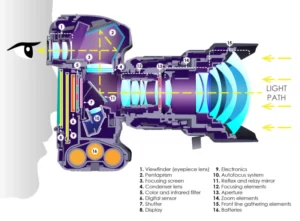
A DSLR camera works by using a combination of optical and digital technologies to capture and store images. The following are the basic steps involved in the functioning of a DSLR camera:
- Light enters the camera through the lens and passes through the aperture, which determines the amount of light that reaches the camera’s image sensor.
- The mirror in the camera reflects the light upwards towards the viewfinder, allowing the photographer to preview and compose the image.
- When the photographer presses the shutter button, the mirror flips up, allowing the light to pass through the shutter and onto the camera’s image sensor.
- The image sensor captures the light and converts it into a digital signal, which is then processed by the camera’s image processing engine.
- The processed image is then stored on the camera’s memory card as a digital file.
DSLR cameras also offer a range of manual controls, including the ability to adjust shutter speed, aperture, and ISO, giving photographers more creative control over their images. Additionally, DSLR cameras allow for interchangeable lenses, allowing photographers to choose the lens that best suits their needs for a particular shot.
“DSLR” Camera Kaise Kam Karta Hai?
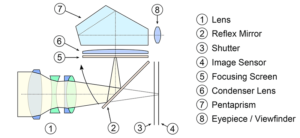
What is a DSLR Camera?
DSLR camera ka kaam optical aur digital technology ka mishran upyog karke kiya jata hai jisse ki tasveeron ka upalambhan aur unka sangrah kiya ja sake. Neeche diye gaye kuch mukhya kadam DSLR camera ke karyakram mein shaamil hote hain:
- Prakash lens ke madhyam se camera mein pravesh karta hai aur aperture se gujar kar camera ke image sensor tak pahunchta hai, jo prakash ki matra ko niyantrit karta hai.
- Camera ke andar sthit darpan ki madad se light viewfinder mein dikhayi deta hai, jisse photographer tasveer ko preview karke compose kar sakta hai.
- Jab photographer shutter button ko dabata hai to camera ke andar sthit darpan ko upar ki taraf hata diya jata hai, jisse prakash shutter aur image sensor tak pahunchta hai.
- Image sensor prakash ko capture karta hai aur use ek digital signal mein badalta hai, jo camera ke image processing engine dvara prakriya kiya jata hai.
- Prakriya kiya gaya tasveer fir memory card mein digital file ke roop mein store ho jati hai.
DSLR cameras ke sath-sath manuaal niyantran ki bhi suvidha hoti hai, jaise shutter speed, aperture aur ISO ke niyantran, jo photographers ko unke tasveeron ke upar adhik se adhik niyantran dene mein madad karta hai. DSLR cameras interchangeable lenses ki bhi suvidha dete hain, jisse photographers kisi bhi ek tasveer ke liye unhe sahi lens chun sakte hain.
There are three main types of DSLR cameras:

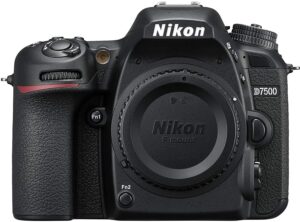
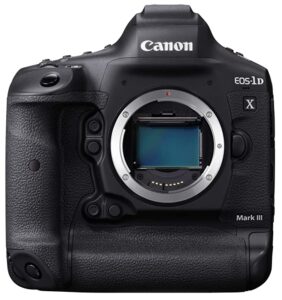
- Entry-level DSLR Cameras: These cameras are designed for beginners who are looking to explore photography as a hobby or profession. They are lightweight, easy to use, and come with basic features and settings.
- Mid-range DSLR Cameras: These cameras offer a range of advanced features and settings, making them ideal for photographers who want to take their skills to the next level. They typically have better image quality, faster shooting speeds, and more advanced autofocus systems.
- Professional DSLR Cameras: These cameras are designed for professional photographers who require the highest level of image quality and performance. They typically have larger image sensors, faster shooting speeds, and advanced features such as weather sealing and dual memory card slots.
Apart from these three main categories, there are also specialized DSLR cameras, such as sports cameras, wildlife cameras, and high-resolution cameras, that cater to specific photography needs.
The disadvantage of DSLRs.
There are several benefits of using a DSLR camera:
- Image Quality: DSLR cameras are capable of producing high-quality images with superior clarity, sharpness, and depth of field.
- Flexibility: DSLR cameras offer a lot of flexibility in terms of manual controls, interchangeable lenses, and accessories, allowing photographers to take creative control over their images.
- Speed: DSLR cameras have fast autofocus systems and high-speed continuous shooting modes that enable photographers to capture fast-moving subjects such as sports and wildlife.
- Low Light Performance: DSLR cameras have large sensors that perform well in low light conditions, allowing photographers to capture clear and detailed images even in challenging lighting situations.
- Depth of Field Control: DSLR cameras offer more control over depth of field, allowing photographers to create blurred backgrounds for artistic effect or to isolate a subject from the background.
- Durability: DSLR cameras are built to withstand tough conditions and are often weather-sealed to protect against dust and moisture.
Overall, DSLR cameras are versatile and powerful tools that offer photographers a range of creative possibilities and the ability to capture high-quality images in a variety of situations.
What is a Mirror-less Camera?
A mirrorless camera is a type of digital camera that uses an image sensor to capture photos and videos instead of a traditional mirror and optical viewfinder found in a DSLR camera.
In a mirrorless camera, light enters through the lens and directly hits the camera’s image sensor, which then sends a preview of the image to an electronic viewfinder or the rear LCD screen. This allows photographers to see the image they are about to capture in real-time and make adjustments to settings such as exposure, focus, and white balance.
Mirrorless cameras are generally smaller and lighter than DSLR cameras, as they do not require a mirror and pentaprism system to reflect light into an optical viewfinder. They also tend to have faster autofocus systems, higher burst rates, and better video capabilities than DSLR cameras.
Mirrorless cameras have gained popularity in recent years, especially among photographers who value portability, speed, and advanced features. However, DSLR cameras still offer advantages in areas such as battery life, durability, and lens selection.
DSLR vs Mirrorless Camera
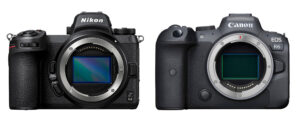

DSLR and Mirrorless cameras are two popular types of digital cameras that have some key differences. Here are some of the main differences between the two:
- Size and Weight: Mirrorless cameras are generally smaller and lighter than DSLRs, making them more portable and easier to handle.
- Autofocus System: Mirrorless cameras use contrast-detection autofocus, which is more accurate and faster than the phase-detection autofocus used in DSLRs. However, DSLRs still have an edge in autofocus performance when it comes to tracking moving subjects.
- Electronic Viewfinder: Mirrorless cameras use electronic viewfinders (EVFs) that display a digital preview of the image, while DSLRs use optical viewfinders that show the actual scene through the lens. Some photographers prefer the optical viewfinder of a DSLR for its clarity and realism, while others prefer the versatility and features of an EVF.
- Battery Life: DSLRs generally have longer battery life than mirrorless cameras, as they use optical viewfinders and do not require as much power to operate.
- Lens Selection: DSLRs have a larger selection of lenses available, as they have been around for longer and have established lens systems. However, mirrorless cameras are catching up quickly in terms of lens selection.
In summary, while both DSLRs and Mirrorless cameras have their advantages and disadvantages, the choice between the two ultimately depends on the individual photographer’s needs, preferences, and shooting style.
How Mirror-less Camera Works?
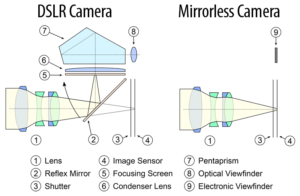
Mirrorless cameras work by using a digital image sensor to capture light through the lens and convert it into a digital image. Unlike DSLR cameras, they do not have a mirror mechanism to reflect the light into an optical viewfinder. Instead, they use an electronic viewfinder (EVF) or a rear LCD screen to display a digital preview of the image.
When you press the shutter button on a mirrorless camera, the camera’s autofocus system uses the image sensor to focus the lens on the subject. The camera then captures the image by electronically recording the light that passes through the lens onto the image sensor.
The image sensor on a mirrorless camera is usually larger than that of a point-and-shoot camera or smartphone, which allows for better image quality and performance in low light conditions. Mirrorless cameras also have fast autofocus systems, which use contrast detection or phase detection methods to focus on the subject quickly and accurately.
Overall, mirrorless cameras are smaller, lighter, and more portable than DSLR cameras, making them a popular choice for photographers who value flexibility and portability. However, they may have some disadvantages such as shorter battery life and limited lens selection, depending on the specific model.

